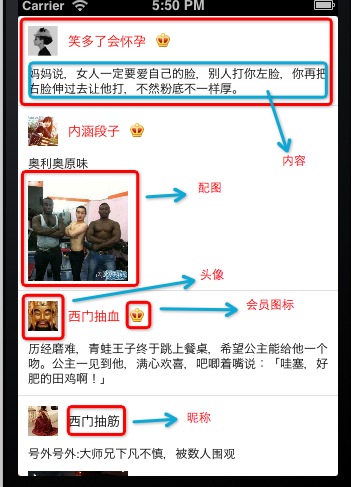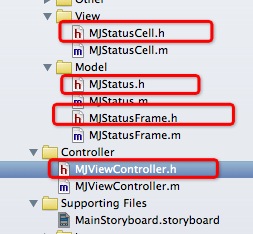先看一下,我们将要做出的效果:

如上图中,现在分析:
- 1,这像是一个表格,而表格的每一个cell高度不定。
- 2,头像不一样
- 3,昵称不一样,昵称的字数也不一样
- 4,有的有会员图标(昵称显示红色),有的没有(昵称显示黑色)
- 5,内容不一样,内容的高度不定
- 6,有的有配图,有的没有配图
如果使用xib创建,那么cell的高度无法确定,控件的位置无法确定,所以,我们采用,整个表格使用一个UITableViewController, 里边的cell采用代码创建。数据使用加载plist文件的方式。
先看一下我们的plist文件:

一:文件分类及作用:

- 1,视图文件:StatusCell, 对应的是表格中的cell 。 也就是表格在加载UITableViewCell的时候,我们要用代码创建出来。
- 2,模型文件:有两个Status 和 StatusFrame,第一个是Status, 用于提供数据,例如,昵称,图片的名称,内容,等等。 第二个是StatusFrame, 用于提供cell中的各个控件的frame, 比如,图片大小及位置,内容的大小及位置,等等。
- 3,控制器:ViewController 这个ViewController继承自UITableViewController, 这样就拥有了UITableView的各个属性。
- 4, 还有一点,我们的storyboard文件中,我们直接拖一个UITableView即可,同时,在属性设置框中将它的Custom Class 设置为ViewController 。
二:各个文件的代码:
1,ViewController.m文件中的代码:
1
2
3
4
5
6
7
8
9
10
11
12
13
14
15
16
17
18
19
20
21
22
23
24
25
26
27
28
29
30
31
32
33
34
35
36
37
38
39
40
41
42
43
44
45
46
47
48
49
50
51
52
53
54
55
56
57
58
59
60
61
62
63
| #import "MJViewController.h"
#import "MJStatus.h"
#import "MJStatusCell.h"
#import "MJStatusFrame.h"
@interface MJViewController ()
@property(nonatomic,strong)NSArray *statusFrames;
@end
@implementation MJViewController
- (void)viewDidLoad
{
[super viewDidLoad];
}
/** 懒加载(只加载一次) */
-(NSArray *)statusFrames{
if(_statusFrames == nil){
NSString *path = [[NSBundle mainBundle] pathForResource:@"statuses.plist" ofType:nil];
NSArray *dictArray = [NSArray arrayWithContentsOfFile:path];
NSMutableArray *statusFrameArray = [NSMutableArray array];
for (NSDictionary *dict in dictArray) {
MJStatus *status = [MJStatus statusWithDict:dict];
MJStatusFrame *statusFrame = [[MJStatusFrame alloc] init];
statusFrame.status = status;
[statusFrameArray addObject:statusFrame];
}
_statusFrames = statusFrameArray;
}
return _statusFrames;
}
#pragma mark - UITableView的数据源方法
/** 返回本组数据有多少行 */
-(NSInteger)tableView:(UITableView *)tableView numberOfRowsInSection:(NSInteger)section{
return self.statusFrames.count;
}
#pragma mark 返回每一组的UITableViewcell
-(UITableViewCell *)tableView:(UITableView *)tableView cellForRowAtIndexPath:(NSIndexPath *)indexPath{
// 1,创建cell
MJStatusCell *cell = [MJStatusCell cellWithTableView:tableView];
// 2,设置cell的数据和控件的frame
cell.statusFrame = self.statusFrames[indexPath.row];
return cell;
}
/** 每一行的高度 */
-(CGFloat)tableView:(UITableView *)tableView heightForRowAtIndexPath:(NSIndexPath *)indexPath{
MJStatusFrame *statusFrame = self.statusFrames[indexPath.row];
return statusFrame.cellHeight;
}
@end
|
2,StatusCell.h中的代码:
1
2
3
4
5
6
7
8
| #import <UIKit/UIKit.h>
@class MJStatusFrame;
@interface MJStatusCell : UITableViewCell
@property(nonatomic,strong) MJStatusFrame *statusFrame;
+(id)cellWithTableView:(UITableView *)tableView;
@end
|
StatusCell.m中的代码:
1
2
3
4
5
6
7
8
9
10
11
12
13
14
15
16
17
18
19
20
21
22
23
24
25
26
27
28
29
30
31
32
33
34
35
36
37
38
39
40
41
42
43
44
45
46
47
48
49
50
51
52
53
54
55
56
57
58
59
60
61
62
63
64
65
66
67
68
69
70
71
72
73
74
75
76
77
78
79
80
81
82
83
84
85
86
87
88
89
90
91
92
93
94
95
96
97
98
99
100
101
102
103
104
105
106
107
108
109
110
111
112
113
114
115
116
117
118
119
120
121
122
123
124
125
126
127
128
129
130
131
132
133
134
| #import "MJStatusCell.h"
#import "MJStatus.h"
#import "MJStatusFrame.h"
#define MJNameFont [UIFont systemFontOfSize:13]
#define MJTextFont [UIFont systemFontOfSize:12]
@interface MJStatusCell ()
/**
头像
*/
@property(nonatomic,weak) UIImageView *iconImgView;
/** 昵称 */
@property(nonatomic,weak) UILabel *nameLbl;
/** 会员图标 */
@property(nonatomic,weak) UIImageView *vipImgView;
/** 正文 */
@property(nonatomic,weak) UILabel *textLbl;
/** 配图 */
@property(nonatomic,weak) UIImageView *pictureImgView;
@end
@implementation MJStatusCell
+(id)cellWithTableView:(UITableView *)tableView{
static NSString *flag = @"status";
MJStatusCell *cell = [tableView dequeueReusableCellWithIdentifier:flag];
if(cell == nil){
cell = [[MJStatusCell alloc] initWithStyle:UITableViewCellStyleDefault reuseIdentifier:flag];
}
return cell;
}
- (id)initWithStyle:(UITableViewCellStyle)style reuseIdentifier:(NSString *)reuseIdentifier
{
self = [super initWithStyle:style reuseIdentifier:reuseIdentifier];
if (self) {
//头像
UIImageView *iconImgView = [[UIImageView alloc] init];
[self.contentView addSubview:iconImgView];
self.iconImgView = iconImgView;
//昵称
UILabel *nameLbl = [[UILabel alloc] init];
nameLbl.font = MJNameFont;
[self.contentView addSubview:nameLbl];
self.nameLbl = nameLbl;
//会员头像
UIImageView *vipImgView = [[UIImageView alloc] init];
vipImgView.image = [UIImage imageNamed:@"vip"];
[self.contentView addSubview:vipImgView];
self.vipImgView = vipImgView;
//正文
UILabel *textLbl = [[UILabel alloc] init];
textLbl.numberOfLines = 0;
textLbl.font = MJTextFont;
[self.contentView addSubview:textLbl];
self.textLbl = textLbl;
//配图
UIImageView *pictureImgView = [[UIImageView alloc] init];
[self.contentView addSubview:pictureImgView];
self.pictureImgView = pictureImgView;
}
return self;
}
-(void)setStatusFrame:(MJStatusFrame *)statusFrame{
_statusFrame = statusFrame;
//1,设置数据
[self settingData];
//2,设置frame
[self settingFrame];
}
/**
设置数据
*/
-(void)settingData{
/** 头像 */
self.iconImgView.image = [UIImage imageNamed:self.statusFrame.status.icon];
/** 昵称 */
self.nameLbl.text = self.statusFrame.status.name;
/** 会员头像 */
if(self.statusFrame.status.vip){
self.vipImgView.hidden = NO;
self.nameLbl.textColor = [UIColor redColor];
}else{
self.vipImgView.hidden = YES;
self.nameLbl.textColor = [UIColor blackColor];
}
/** 正文 */
self.textLbl.text = self.statusFrame.status.text;
/** 配图 */
if(self.statusFrame.status.picture){
self.pictureImgView.hidden = NO;
self.pictureImgView.image = [UIImage imageNamed:self.statusFrame.status.picture];
}else{
self.pictureImgView.hidden = YES;
}
}
/**
设置frame
*/
-(void)settingFrame{
/** 头像 */
self.iconImgView.frame = self.statusFrame.iconFrame;
/** 昵称 */
self.nameLbl.frame =self.statusFrame.nameFrame;
/** 会员头像 */
self.vipImgView.frame = self.statusFrame.vipFrame;
/** 正文 */
self.textLbl.frame = self.statusFrame.textFrame;
/** 配图 */
if(self.statusFrame.status.picture){
self.pictureImgView.frame = self.statusFrame.pictureFrame;
}
}
@end
|
3, status.h中的代码:
1
2
3
4
5
6
7
8
9
10
11
12
13
14
15
16
17
18
| #import <Foundation/Foundation.h>
@interface MJStatus : NSObject
/** 正文 */
@property(nonatomic,copy) NSString *text;
/** 头像 */
@property(nonatomic,copy) NSString *icon;
/** 昵称 */
@property(nonatomic,copy) NSString *name;
/** 配图 */
@property(nonatomic,copy) NSString *picture;
/** 会员 */
@property(nonatomic,assign) BOOL vip;
+(id)statusWithDict:(NSDictionary *)dict;
-(id)initWithDict:(NSDictionary *)dict;
@end
|
Status.m中的代码:
1
2
3
4
5
6
7
8
9
10
11
12
13
14
15
| #import "MJStatus.h"
@implementation MJStatus
+(id)statusWithDict:(NSDictionary *)dict{
return [[self alloc] initWithDict:dict];
}
-(id)initWithDict:(NSDictionary *)dict{
if(self = [super init]){
[self setValuesForKeysWithDictionary:dict];
}
return self;
}
@end
|
4,StatusFrame.h文件中的代码:
1
2
3
4
5
6
7
8
9
10
11
12
13
14
15
16
17
| #import <Foundation/Foundation.h>
@class MJStatus;
@interface MJStatusFrame : NSObject
@property(nonatomic,assign,readonly) CGRect iconFrame;
@property(nonatomic,assign,readonly) CGRect nameFrame;
@property(nonatomic,assign,readonly) CGRect vipFrame;
@property(nonatomic,assign,readonly) CGRect textFrame;
@property(nonatomic,assign,readonly) CGRect pictureFrame;
@property(nonatomic,assign,readonly) CGFloat cellHeight;
@property(nonatomic,strong) MJStatus *status;
@end
|
StatusFrame.m中的代码:
1
2
3
4
5
6
7
8
9
10
11
12
13
14
15
16
17
18
19
20
21
22
23
24
25
26
27
28
29
30
31
32
33
34
35
36
37
38
39
40
41
42
43
44
45
46
47
48
49
50
51
52
53
54
55
56
57
58
59
60
|
#import "MJStatusFrame.h"
#import "MJStatus.h"
#define MJNameFont [UIFont systemFontOfSize:13]
#define MJTextFont [UIFont systemFontOfSize:12]
@implementation MJStatusFrame
-(void)setStatus:(MJStatus *)status{
_status = status;
CGFloat padding = 10;
CGFloat iconX = padding;
CGFloat iconY = padding;
CGFloat iconW = 30;
CGFloat iconH = 30;
_iconFrame = CGRectMake(iconX, iconY, iconW, iconH);
/** 昵称 */
CGFloat nameX = CGRectGetMaxX(_iconFrame) + padding;
CGSize nameMaxSize = [self.status.name sizeWithFont:MJNameFont];
CGFloat nameW = nameMaxSize.width;
CGFloat nameH = nameMaxSize.height;
CGFloat nameY = padding + (iconH - nameH) * 0.5;
_nameFrame = CGRectMake(nameX, nameY, nameW, nameH);
/** 会员头像 */
CGFloat vipX = CGRectGetMaxX(_nameFrame) + padding;
CGFloat vipY = nameY;
CGFloat vipW = 14;
CGFloat vipH = 14;
_vipFrame = CGRectMake(vipX, vipY, vipW, vipH);
/** 正文 */
CGFloat textX = iconX;
CGFloat textY = CGRectGetMaxY(_iconFrame) + padding;
CGFloat textW = 300;
CGSize textMaxSize = [self.status.text sizeWithFont:MJTextFont constrainedToSize:CGSizeMake(300, MAXFLOAT) lineBreakMode:UILineBreakModeCharacterWrap];
CGFloat textH = textMaxSize.height;
_textFrame = CGRectMake(textX, textY, textW, textH);
/** 配图 */
CGFloat pictureX = iconX;
CGFloat pictureY = CGRectGetMaxY(_textFrame) + padding;
CGFloat pictureW = 100;
CGFloat pictureH = 100;
_pictureFrame = CGRectMake(pictureX, pictureY, pictureW, pictureH);
if(self.status.picture){
_cellHeight = CGRectGetMaxY(_pictureFrame) + padding;
}else{
_cellHeight = CGRectGetMaxY(_textFrame) + padding;
}
}
@end
|
虽然贴上了代码,还是要说一下这个过程:
1,在控制器初始化的时候,从plist文件中将数据提取出来,然后放到Status这个模型中,在创建一个StatusFrame模型,这个StatusFrame模型中有一个属性是Status, 而数组中放入的就是StatusFrame这个模型对象。 在赋值的时候,就把各个控件的frame 以 cell的高度计算了出来。
2,控制器初始化完以后,会先加载一共有多少组这个方法,-(NSInteger)numberOfSectionsInTableView: ,
3,继续加载每组有多少行这个方法:-(NSInteger)tableView:numberOfRowsInSection:
4,继续加载 -(CGFloat)tableView:heightForRowAtIndexPath: 这个方法,这个方法主要是返回表格中,每一行的高度,这时候,我们就可以从已经加载完的数组将cell的高度提取出来了。
5,加载完每一组高度这个方法之后,会继续加载 -(UITableViewCell *)tableView:cellForRowAtIndexPath: 这个方法是返回每一行的cell. 这段代码被调用的频率非常高,不用在这段代码中频繁创建cell,这样效率会有点低。现在粘上此段代码:
1
2
3
4
5
6
7
| // 1,创建cell
MJStatusCell *cell = [MJStatusCell cellWithTableView:tableView];
// 2,设置cell的数据和控件的frame
cell.statusFrame = self.statusFrames[indexPath.row];
return cell;
|
第一行代码,就是创建一个cell,创建cell代码如下:
1
2
3
4
5
6
7
8
9
10
| +(id)cellWithTableView:(UITableView *)tableView{
static NSString *flag = @"status";
MJStatusCell *cell = [tableView dequeueReusableCellWithIdentifier:flag];
if(cell == nil){
cell = [[MJStatusCell alloc] initWithStyle:UITableViewCellStyleDefault reuseIdentifier:flag];
}
return cell;
}
|
这段代码是采用,先从缓存池中去查找,是否有被先前不用的cell ,如果没有,就去创建一个cell,如果有cell,直接返回cell,如果没有cell,就直接创建一个cell。当然,在创建cell的时候,我们会创建这个cell中的子控件。
再看 cell.statusFrame = self.statusFrames[indexPath.row]; 这行代码,这行代码是将存在数组中的模型对象数据提取出来,赋值给cell的frame对象,在赋值的时候,我们会设置cell控件中的数据和空间的frame.
现在贴上赋值的代码:
1
2
3
4
5
6
7
8
9
10
11
12
13
14
15
16
17
18
19
20
21
22
23
24
25
26
27
28
29
30
31
32
33
34
35
36
37
38
39
40
41
42
43
44
45
46
47
48
49
50
51
52
53
54
55
56
57
58
59
60
61
62
63
64
65
66
67
68
| -(void)setStatusFrame:(MJStatusFrame *)statusFrame{
_statusFrame = statusFrame;
//1,设置数据
[self settingData];
//2,设置frame
[self settingFrame];
}
/**
设置数据
*/
-(void)settingData{
/** 头像 */
self.iconImgView.image = [UIImage imageNamed:self.statusFrame.status.icon];
/** 昵称 */
self.nameLbl.text = self.statusFrame.status.name;
/** 会员头像 */
if(self.statusFrame.status.vip){
self.vipImgView.hidden = NO;
self.nameLbl.textColor = [UIColor redColor];
}else{
self.vipImgView.hidden = YES;
self.nameLbl.textColor = [UIColor blackColor];
}
/** 正文 */
self.textLbl.text = self.statusFrame.status.text;
/** 配图 */
if(self.statusFrame.status.picture){
self.pictureImgView.hidden = NO;
self.pictureImgView.image = [UIImage imageNamed:self.statusFrame.status.picture];
}else{
self.pictureImgView.hidden = YES;
}
}
/**
设置frame
*/
-(void)settingFrame{
/** 头像 */
self.iconImgView.frame = self.statusFrame.iconFrame;
/** 昵称 */
self.nameLbl.frame =self.statusFrame.nameFrame;
/** 会员头像 */
self.vipImgView.frame = self.statusFrame.vipFrame;
/** 正文 */
self.textLbl.frame = self.statusFrame.textFrame;
/** 配图 */
if(self.statusFrame.status.picture){
self.pictureImgView.frame = self.statusFrame.pictureFrame;
}
}
|
通过代码自定义cell(cell的高度不一致)
总结:
1,新建一个继承自UITableViewCell类。
2,重新这个类的initWithStyle:reuseIdentifier:方法
a,添加所有需要显示的子控件(不需要设置子控件的数据和frame,子控件要添加到contentView中)
b,进行子控件的一次性的属性设置(有些属性只需要设置一次,比如,字体,固定的图片等)
3,提供2个模型
a,数据模型:存放文字数据\图片数据
b,frame模型:存放数据模型,以及所有子控件的frame,以及cell的高度
4,cell拥有一个frame模型(不要直接拥有数据模型)
5,重写frame模型属性的setter方法:在这个方法中设置子控件的显示数据和frame
6, frame模型数据的初始化采用懒加载的方式(每一个cell对应的frame模型数据只加载一次)


